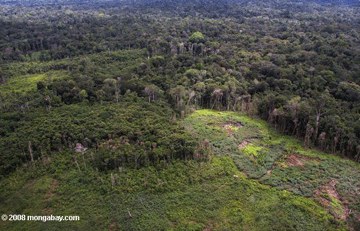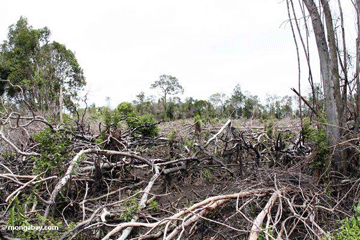.
  Small-holder deforestation in Suriname (top) and Borneo (bottom) |
biologically, Tropical forests, the richest ecosystem on earth and plays an important role in regional hydrology, carbon storage, and global climate. But the destruction of tropical forests continues apace, with some 13 million hectares of forest razed each year. Although this figure has not changed markedly in recent decades, the basis of the driving deforestation is shifting - from the most deforestation is driven by the necessities of life in the 1960s to 1980s, to more deforestation is driven by the industry in recent years . This trend, we assert, has key implications for forest conservation.
tropical deforestation from the 1960s to 1980s, is blown widely by government policies for rural development, including agricultural loans, tax incentives, and road construction, together with rapid population growth in many developing countries. These initiatives, especially noticeable in countries like Brazil and Indonesia, encouraging the emergence of a dramatic influx of population into the border area and often lead to rapid deforestation. The notion that small-scale farmers and cultivators who move are responsible for most forest loss leads to conservation approaches such as Integrated Conservation and Development Projects (ICDP), which attempted to link nature conservation with sustainable rural development. However, today many who believed that ICDPs have often failed due to weaknesses in planning and implementation, and because the local people used to use ICDP funds to increase their income, not to replace the profits they have earned from exploiting nature.
Small-holder deforestation in Suriname (top) and Borneo (bottom)
More recently, the direct impact of rural communities in tropical forests appear to have stabilized and even decreased in some areas. Although many tropical countries still have high population growth, a strong trend of urbanization in developing countries (except in Sub-Saharan Africa) showed that rural populations are growing more slowly, and in some countries began to decline. Popularity of the program to the border population movements on a large scale has also waned in some countries. If such trends continue, they may relieve pressure on forests from small-scale agricultural activities, hunting, and gathering firewood.
At the same time, globalized financial markets and a worldwide commodity creates an environment that is very attractive to the private sector. As a result, industrial logging, mining, oil and gas development, and especially large-scale agriculture increasingly emerging as the dominant cause of tropical deforestation. In Brazilian Amazonia, for example, large-scale farming has exploded, with the number of cattle increased by more than 3-fold (from 22 to 74 million head) since 1990, while industrial logging and soy farming has grown dramatically. Surging demand for grains and edible oils, driven by world demand for biofuels and rising standards of living in developing countries, helping to spur this trend.
Although we and others concerned with the rise of industrial-scale deforestation, we argue that it also signals the emergence of opportunities for protection and forest management. Rather than trying to affect hundreds of millions of forest in the tropics - a daunting challenge, at best - supporting conservation can now focus their attention on the number of corporations exploiting a much smaller source. Many of them are multinationals or domestic companies seeking access to international markets, which encourage them to show some sensitivity to the environmental problems that grow to its global customers and shareholders, such corporations can be vulnerable to attacks on their public image.